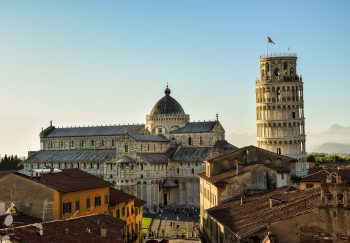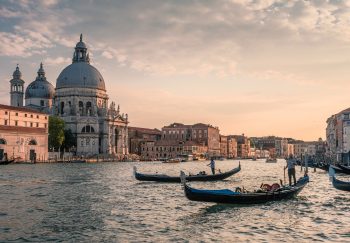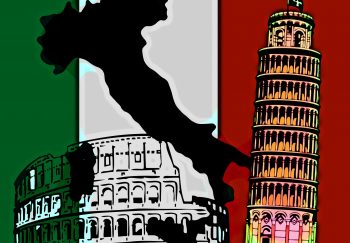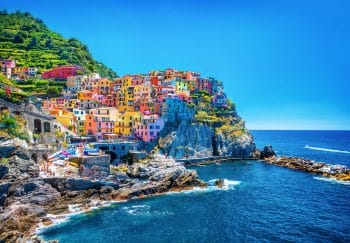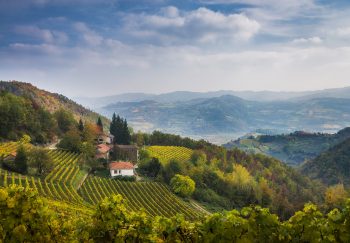Now you have your car rented, know the fuel type, and have mapped out a route to take you on a road trip through Italy. All you need to do now is to understand all the signs on roads in Italy.
Yes, they are numerous.
To have some fun and laughs, I consulted Wikipedia’s page about Italian road signs. It was my 15th year and I immediately felt transported back. I could see how many times I would have failed my driver’s license test if I had to know all the signs. Although it’s an intimidating collection of squares and circles, I will be covering the most important road signs that you need to know if driving in Italy. You can find the entire list on Wikipedia.
Although it is overwhelming, the page does a great job breaking down Italy’s road signs in different shapes. And shapes have meanings before any printed information is placed on them. The circles signify something that is prohibited or requires a specific instruction. Rectangles and Squares indicate information. Triangles indicate danger.
Some colors have meanings, too. The Autostrada has green highway signs, which indicate toll roads. Blue highway signs indicate that there are no toll roads. Brown signs direct you to historic or tourist attractions.
Let’s now get into the details.
Check out my other articles: Driving through Italy 101, and
It’s important to know the signs of the road in Italy
Stop
Italian stop signs are similar to those in the United States, and other countries. They even have English words for “STOP” It’s easy, right? It’s kind of. It’s kind of like the yellow flashing lights or yield signs that Italians use to approach stop signs. They may slow down or not stop completely if there is no one nearby. Also, do not assume that everyone will stop at the stop sign.
Begin & End of Restricted Area
It communicates the beginning and end of a road rule in Italy by using the same sign twice. Once to indicate that a rule is starting and another time to indicate that it is ending. The signs in this photo indicate that you are leaving Oropa (the sign that you saw when you entered the town) and that the 30kmph limit is ending. The color of the slash can change, but remember that you will be looking for the sign’s mate if you have seen it before.
Speed Limit
Speed limit signs – Maximum speed – are black circles with a red border and the speed limit in the middle.
Minimum Speed
A circular sign in blue with the minimum speed in the middle indicates the speed limit.
Do not enter
The signs indicating that vehicles are not allowed to pass them are marked with red circles and a horizontal bar in the middle. It could be that traffic is coming in one direction, but it’s also a pedestrian zone.
Traffic Zone with Limited Traffic
ZTL zones are becoming more common in Italy. ZTL stands for Zone Traffico Limitato, which means there are no vehicles allowed. These signs consist of white circles with a border in red. Sometimes they are empty, other times they have Zona Traffico Limitato written on them. Only one type of vehicle is allowed in the circle. No buses, big delivery trucks, motorcycles, or cars. Driving in a ZTL is a serious offense. You’ll be fined if you do not belong there. There are cameras located in most major cities. This AutoEurope page contains maps showing ZTL zones in some of Italy’s most important cities.
Parking and Stopping are not permitted
Parking signs must be blue circles with a red border around the perimeter and a red slash in the middle. Signs that prohibit parking (or no stopping) are blue circles with a red border. There are also two red slashes in the middle, like a red “X” symbol.
There is no passing
Passing zone signs must be white circles with a red border, and at the center there are two cars. The one to the right is black and the one to the left, which is in the passing lane, is red. The red color indicates that the car is not allowed to do anything. Similar signs may be found with a truck on the left and a car on the right. This is a sign that trucks cannot pass but cars can.
One way
Italian one-way signs used the words “SENSO UNICO” but the new version has no words. You may still see some old ones. One-way signs are squares or rectangles in blue with a white outline indicating which direction traffic is supposed to be going. There are also circular signs in blue with similar white arrows. These indicate that you need to drive straight, left, or in the direction indicated by the arrow. It’s the same result – you will turn in the direction indicated by the arrow. This is not a problem, but be aware that squares and rectangles are true one-way signs.
Right of Way
Right-of-way signs are yellow diamonds with a border of white. I know it may seem confusing but the concept these signs communicate is important. Imagine you are driving on a road other than a highway when you come across a right-of-way sign. This means that any cars coming onto your street from side streets or intersecting roads would have to yield to them – they have to wait for their turn. You will see the same right-of-way sign, but this time with a black slash in the middle (remember the section on “end zone” above). This means that you will have to wait as cars from the side streets have the right-of-way.
Yield
This sign, which is an inverted triangle white with a red border, also tells you you are the one who must wait for other cars.
Parking area
A blue square marked with a white “P” in the middle indicates parking areas, including garages and parking lots. These are important to be aware of as parking garages can sometimes be difficult to spot, especially if they are underground. Parking in historic cities can also be difficult.
City Center
If you are driving into a town from the countryside, look out for the circular white sign with the black concentric circles within it. The sign almost looks like a bullseye with a white dot in the middle. It is possible to park in this area of a city or town, but it can be difficult to find parking. Once you have driven there, you will be able to take the highway exit to find parking lots or garages that are close to the center.
Italian Road Signs in Wild
There are so many signs! There are so many signs!
This sign has a brown indicator of a point-of-interest – in this instance a national park. It also contains the word “uscita,” meaning “exit.”
This sign collection is particularly fun because it is located in northern Italy, and thus in two languages. The non-toll highway leads to Courmayeur, which is the center of Aosta (or Aoste in French), and Autostrade towards Genova, Milano and Torino. It also takes you toward Monte Bianco (or Mont Blanc in French). Last is the customs sign (the circle with red borders and the word “dogana”)
Turn left instead of going into this street.
There is no stopping anywhere on this street. They take it seriously.
Here’s one of these ZTL signs.
Some signs have time limits. For example, no stopping after a certain hour. The time limit sign for this no parking sign is funny, however it’s only a 24-hour ban. It’s not clear why the no parking sign was not sufficient on its own.
Now, let’s have some fun…
It’s too tempting to resist. Here are some Italian road signs with my interpretations. (Their true meanings are below. I don’t want anyone to be in trouble.
No trumpet playing
(No car horns allowed)
There are no cars on fire!
(No explosives are allowed)
There are no invisible motorcycles
(No motorcycles)
There is no soccer!
(End of the “Home Zone”; these are neighborhoods that have lower speed limits.
Be careful: You’re half a Death Star away!
(Tunnel ahead)
